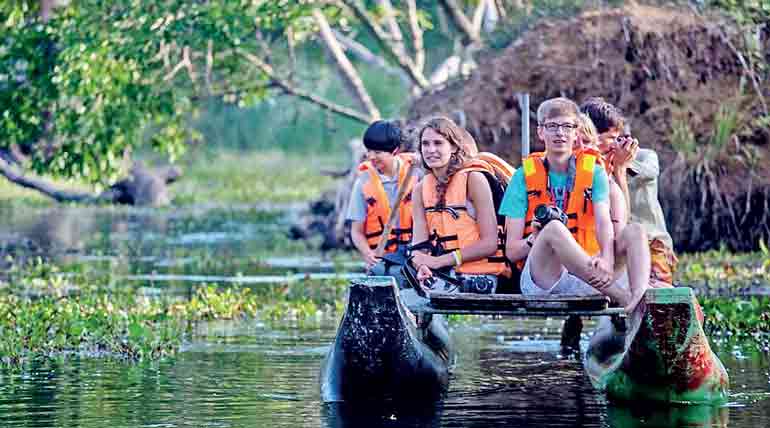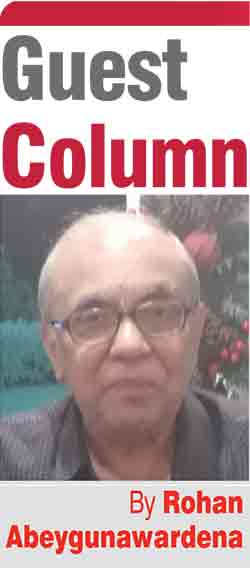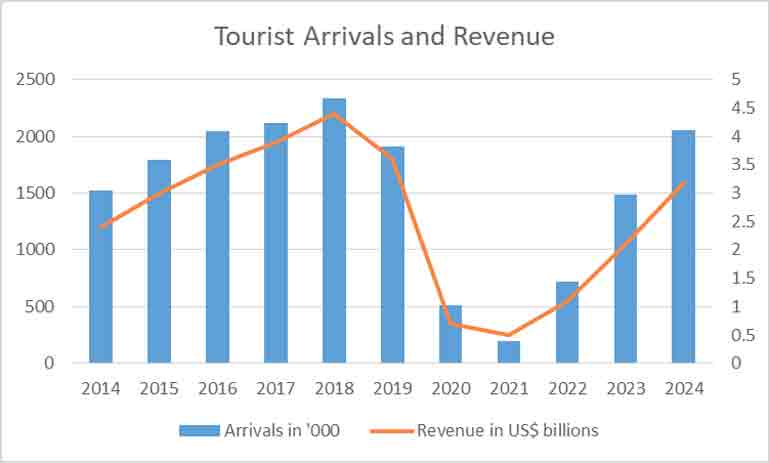Tuesday Nov 11, 2025
Tuesday Nov 11, 2025
Tuesday, 11 November 2025 00:01 - - {{hitsCtrl.values.hits}}

This sector is often called a “cash cow” for a country’s economy because it generates steady and significant income with relatively low investment once established
Generally, tourism is one of the world’s major economic sectors. It is the third-largest export category (after fuels and chemicals) and, in 2019, accounted for 7% of global trade. In some countries, it can account for more than 20% of their GDP. For example, Croatia, with a population of 3.9 million, reached a record 26.38 million international visitors in 2024. Its land area is 56,561 sq. km, a little less than Sri Lanka’s. Its stunning Adriatic coastline is the main attraction for visitors.
This sector is often called a “cash cow” for a country’s economy because it generates steady and significant income with relatively low investment once established.
During the colonial era and many years after independence, Sri Lanka’s main export crop and cash cow was tea.
Since the end of the civil war in 2009, tourism has become a major source of foreign currency for Sri Lanka and a key driver of economic growth.
In 2018, tourism revenue peaked at over $ 4.4 billion (Central Bank Report 2024), but was impacted by events like the Easter attacks in 2019, which caused a significant loss of revenue, dropping it to $ 3.6 billion.
It was also affected by the COVID-19 pandemic in 2020 and 2021. This impact was mainly due to a decline in tourist movement, which affected economies, people’s livelihoods, public services, and opportunities worldwide. It influenced all parts of the extensive value chain, as the decrease in arrivals and revenue due to these events can be clearly seen in the given graph compiled using published statistics.
History of tourism in Sri Lanka
 The phrase “if you don’t know your history, you think short term” is a quote attributed to Lee Kuan Yew, the founding father of modern Singapore. Therefore let us identify the History of Tourism in Sri Lanka, first.
The phrase “if you don’t know your history, you think short term” is a quote attributed to Lee Kuan Yew, the founding father of modern Singapore. Therefore let us identify the History of Tourism in Sri Lanka, first.
Long before modern tourism, Sri Lanka attracted Indian, Chinese, Persian, and Arab traders due to its strategic location along Indian Ocean trade routes. The island has been a prominent and memorable landmark for sailors since ancient times, thanks to the visible presence of Adam’s Peak from the west coast. Sailors used these landmarks to keep a general course and help steer their vessels, even when sailing with the wind.
There were two main types of visitors to the island: explorers and conquerors.
Explorers
Chinese Buddhist monk Fa-Hien visited in the 5th century A.D. and wrote about Anuradhapura and Buddhist sites like Sri Maha Bodhi. Marco Polo visited the island on his return trip from China to Persia and famously described it as “the finest island of its size in all the world.” Two Italian friars, Marignoli and Odoric, visited within twenty years of each other (1329 & 1349 AD), and both were fascinated by the beauty of the island. Moroccan traveller Ibn Battuta visited Sri Lanka in 1344 AD on his journey to China.
Establishing a new culture on the island
The Indian King Ashoka (265–238 BCE), who conquered many kingdoms of India and became the last major emperor of the Mauryan dynasty, realised the sufferings that the war inflicted on the defeated people. That moved him to such remorse that he renounced armed conquests. It was at this time that he came in touch with Buddhism and resolved to live according to Lord Buddha’s preaching, or dharma and to serve his subjects and all humanity. He then adopted a policy of concurring the world through dharma and started sending Buddhist emissaries to neighbouring countries. He had a special liking towards the Sinhala nation of his friend King Devanampiyatissa of Sri Lanka and sent his own son, Mahinda, who was a Buddhist monk, to propagate dharma.
After Mahinda Thero arrived and converted King Devanampiyatissa and his people to Buddhism, a new Sinhala Buddhist culture was born. The villages were established based on the concept “Village, Temple, Tank, and Dagobah.” The biggest mistake King Devanampiyatissa made was dissolving the army. As the people had become very devout, the King would have thought that there was no need for an army to look after security.
Conquerors
Two Indian horse traders, Sena and Guttika, who came to the island, realised that Sri Lanka was an unusual country without a standing army. They returned to India, brought back an army, and killed the then-Sinhala King Surathissa (247–237 BCE), conquering Anuradhapura. They ruled for 22 years before being overthrown by a local prince, Asela.
Since then, South Indian Dravidian-speaking invaders have conquered the island up to 16 times, according to recorded history. Many of these invasions can be linked mainly to economic interests, such as controlling trade routes and ports, given the island’s strategic location. Other reasons included fertile lands and the expansionist ambitions of powerful South Indian empires like the Cholas and Pandyas. The outcome of these invasions was the establishment of a Hindu Tamil culture in the northern part of the island.
Then came the Portuguese in 1505. Their landing on the island was accidental, but realising the potential for trade, they became invaders and conquered the entire coastal area.
The Dutch arrived in Sri Lanka in the late 16th century to pursue their trading ambitions, followed by the British, who captured the entire country by 1815. The British initially administered the island from Madras (Chennai) in southern India, and in 1796, they transformed the country into a “Crown Colony.” From then on, Ceylon was governed from Colombo.
British invested heavily in infrastructure such as railways and roads to support the plantation economy they introduced for their own benefit.
During British rule, they encouraged European royalty to visit their colonies to strengthen imperial power and foster a sense of a grand European “royal international.” Among the many visitors to Ceylon, two stands out because they later met violent deaths and became part of world history. They were Archduke Franz Ferdinand of Austria-Hungary and Nicholas, the Crown Prince of Russia.
The Archduke Franz Ferdinand of Austria-Hungary
The Archduke Franz Ferdinand, heir presumptive to the Austro-Hungarian throne, visited Ceylon in January 1893 during a world tour. His visit was well documented, with his notes describing scenic drives, his enjoyment of views in Kandy, and his enchantment with a devil dance performance. He also wrote about hunting expeditions, shooting several elephants in Kalawewa.
Archduke Franz Ferdinand was assassinated on June 28, 1914, in Serbia by Gavrilo Princip, a Bosnian Serb nationalist. This event triggered a series of alliances, with Austria-Hungary, backed by Germany, declaring war on Serbia. Russia mobilized to support Serbia, prompting Germany to declare war on Russia and France. Britain then declared war on Germany, leading Europe into full-scale conflict. This marked the start of the First World War, which ended on 11 November 1918, with the signing of the armistice.
The Russian Crown Prince
The Crown Prince of Russia, Nicholas, known as Tsarevich (the eldest son of the Russian emperor), visited Ceylon in 1891 as part of his “Eastern Journey.” The visit took place from 11 February to 11 March 1891.
Tsarevich toured the Royal Botanical Gardens in Peradeniya with its director, Dr. Henry Trimen. He planted an ironwood tree (kd .i) in the gardens to commemorate his visit. (Ironwood Tree was declared the national tree of the country on February 26, 1986) Later that evening, he and his party attended a state dinner, followed by a special Perehara featuring native chiefs in full dress, 30 to 40 elephants, and dancers, including ‘devil dancers.” The next morning, they enjoyed a private viewing of the Tooth Relic, then travelled by train to Nanu Oya before spending the next two days exploring and hunting in Nuwara Eliya.
The young prince visited the Drawella Club of British Planters, located about two kilometres from Dickoya, on the 14th of Saturday, 1891, leaving a lasting impression on the locals.
Three years later, he became Tsar Nicholas II when he ascended the throne. His coronation took place on May 26, 1896.
Following the October Revolution in Russia in 1917, Tsar Nicholas II and the entire royal family were executed by the Bolshevik Red Guards.

Formal development of tourism in the island
It was the British who recognised the potential of tourism in Ceylon and established the Tourism Bureau in 1937. However, World War II disrupted this development.
Post-war recovery in Western Europe led to the growth of tourism as an invisible import and a diplomatic tool. International travel agencies emerged across European countries, leading efforts to simplify travel logistics.
After independence, J.R. Jayewardene initiated formal tourism development in 1965 when he served as the state minister under Prime Minister Dudley Senanayake’s government. He appointed Anandatissa de Alwis, an advertising and marketing expert, as the Permanent Secretary to his ministry. This was the first instance an outsider other than an officer from the Ceylon Civil Service was appointed as a Permanent Secretary to a ministry.
The Ministry of State released the first Ten-Year Master Plan for tourism, establishing a solid foundation for future promotion and marketing strategies. The Government also enacted key laws, such as the Tourist Board Act, the Ceylon Hotel Corporation Act, and the Tourist Development Act, providing a structured framework for investment and growth in tourism.
Recognising the need for manpower in this labour-intensive industry, which requires numerous staff from front desk to housekeeping, food and beverage, and maintenance, the Government started a hotel school in 1966 at Samudra Hotel in Galle Face.
This historic building, once known as “Race Bungalow,” or the grandstand when horse racing was held at Galle Face Green from the early 1820s until 1893, still stands and now functions as the Crystal Ballroom of the Taj Samudra Hotel.
Jayewardene’s efforts to revitalise tourism led to a significant boom in the industry.
Critiques of tourism development on the island, however, were quite vocal. The Opposition often criticised, with some prominent leftist politicians arguing it was better to build houses for the poor rather than hotels, as many private sector projects were underway.
Another main critique was that tourism would damage Sri Lanka’s culture, a theory easily promoted within Sri Lankan society. During this period, hippies created their communities, listened to psychedelic music, embraced the sexual revolution, and used drugs like cannabis, LSD, peyote, and psilocybin mushrooms to explore altered states of consciousness. Many hippies travelled through Sri Lanka as tourists.
The Opposition exploited these issues to attack the Government. Leading up to the 1970 general election, a prominent Opposition speaker recounted an incident in Anuradhapura, a sacred Buddhist city.
He said at a well-attended public meeting “After addressing several meetings, I checked into the local rest house, lit a cigar after dinner, and noticed a noise from a nearby room through an open window. Curious, I peered inside.” Then he remarked in Sinhala, “lshkav lk.dgqhs ifydorjreks. wfma ixialD;sh úfoai ixialD;shlg hgfj,d” (“Comrades, very sorry to say, one of our own culture is under the domination of a foreign culture”). He got a thundering applause from the crowd.
In May 1970,Sirimavo Bandaranaike led the United Front, a coalition including leftist parties, to victory—an Opposition figure mentioned earlier was appointed as a minister.
The hotel projects initiated earlier were completed between 1972 and 1974.
The United Left Front (ULF) government, under Bandaranaike, appointed a minister of tourism to continue promoting the industry. During the 1975 Non-Aligned Conference, a key event hosted by Prime Minister Bandaranaike, these hotels proved very useful.
Since then, successive Governments have continued to promote Sri Lanka’s tourism and hotel industries, building on J.R. Jayewardene’s initial initiatives.
The future of Sri Lanka’s tourism industry
The centre-left Government of Anura Kumara Disanayake, which came to power two years after Sri Lanka’s 2022 economic crisis, is now promoting tourism to boost the national economy.
They see tourism as a key sector for economic growth, especially because of its potential to generate significant income and create jobs for rural communities and youth. Their initiatives focus on revitalising the industry, improving infrastructure, and encouraging a wider range of tourism experiences, such as eco-tourism and community-based tourism, to achieve sustainable growth.
The Government has successfully negotiated a $ 100 million loan package from the Asian Development Bank (ADB) – 70 million as a concessional loan and 30 million as a regular loan for tourism promotion, the Government is looking forward to tourism as a major source of foreign exchange earnings for 2026.
Over-reliance on the tourism
However, over-reliance on the tourism industry poses significant risks because it is highly vulnerable to global crises like pandemics, economic downturns, or acts of terrorism, which can cause a sharp and prolonged decline in revenue and employment. Sri Lanka experienced this when the island was hit by a series of deadly blasts on 21 April 2019 (Easter Sunday bombing), and during the COVID-19 pandemic. This is clearly illustrated in the graphical representation of Tourist Arrivals and Income Generation provided.
To reduce such risks, the current Government should focus on other sectors such as agriculture and renewable energy.
It is also advisable to attract Foreign Direct Investment (FDI) to develop these sectors, for example, to modernise agriculture and capitalise on the island’s significant potential for both solar and wind power, with solar energy having abundant potential from sunshine and wind power offering strong onshore and offshore resources.
The development of the renewable energy sector would be a springboard for economic development, no doubt, as energy is crucial for industries, modernised agriculture, and to enhance the living standards of people. Besides, excess electricity could be either exported to South India or used to produce green hydrogen gas, which also could be either exported or used later to generate electricity or in other applications.
(The writer could be contacted on [email protected].)